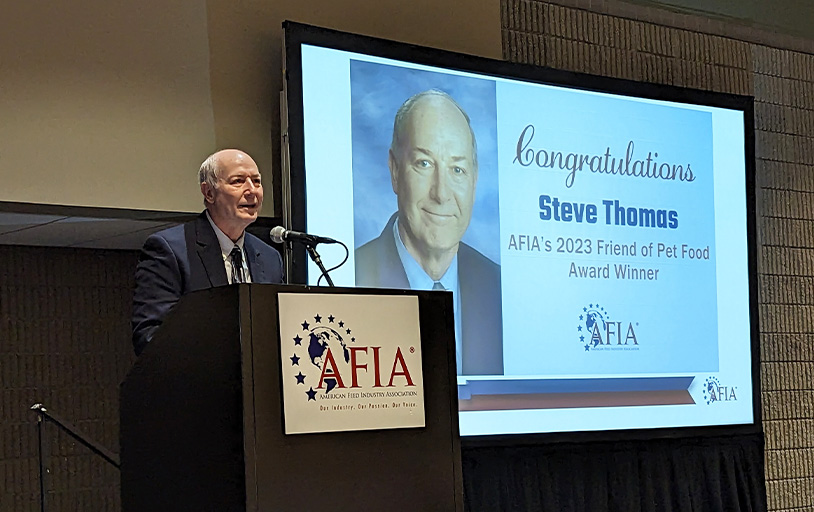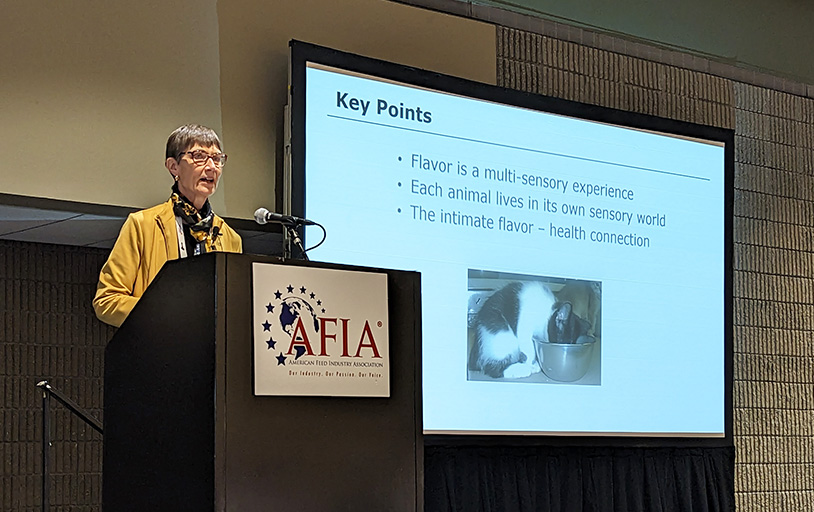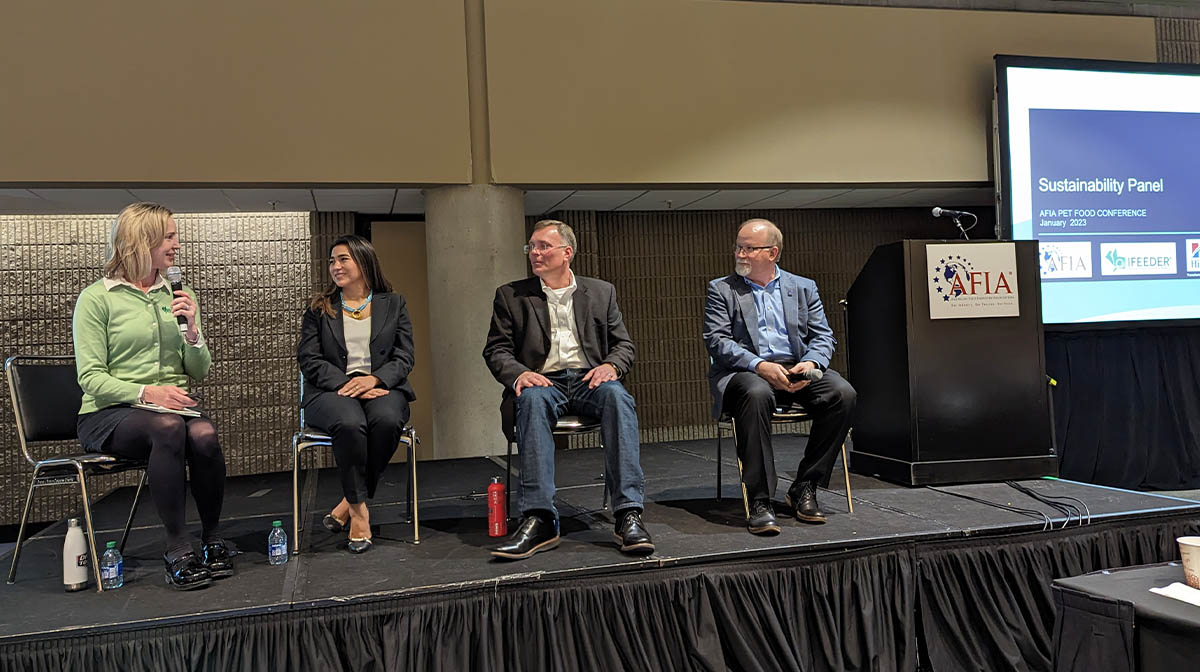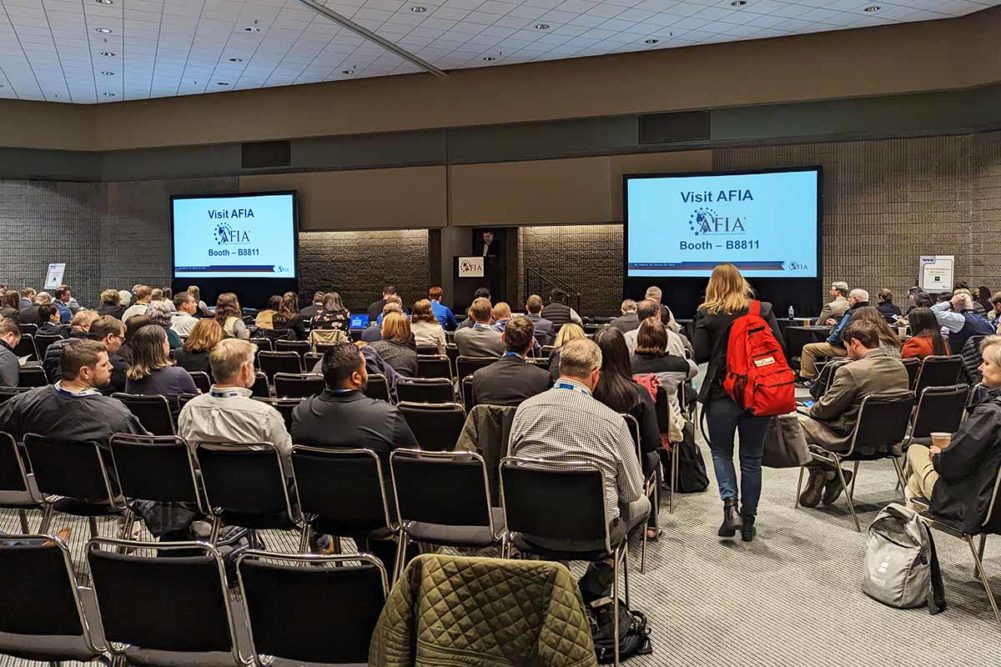ATLANTA — Nearly 400 industry professionals convened at the 2023 Pet Food Conference in Atlanta, held Jan. 24 in conjunction with the International Production & Processing Expo (IPPE). Attendees spanned pet food manufacturers, ingredient and equipment suppliers, regulatory officials, aspiring students, and other industry stakeholders, representing what the American Feed Industry Association (AFIA) described as a “pre-pandemic” turnout.
"We had a packed room the entire day and certainly learned a lot," said Louise Calderwood, directory of regulatory affairs at the AFIA.
During the conference, Eric Altom, Ph.D., technical nutritionist and innovation lead at Balchem, presented the 2023 Friend of Pet Food Award to Steve Thomas, vice president of Darling Ingredients’ protein division. Thomas was recognized by fellow industry members and the AFIA for his longstanding contributions to advance the pet food industry.
“I’ve worked in this industry for 39 years, and it’s truly been a privilege,” Thomas said upon receiving the award. “I’ve seen this move from making animal feed for pets to making food for our four-legged family members, and that’s been really cool to see that development and be a part of it.”
 Steve Thomas, vice president of Darling Ingredients’ protein division. (Photo by Sosland Publishing Co.)
Steve Thomas, vice president of Darling Ingredients’ protein division. (Photo by Sosland Publishing Co.) Thomas attributed his own success and that of Darling Ingredients to industry-wide transparency, and noted sustainability as the “biggest challenge” he sees facing the industry over the next 10 years.
The morning began with a complimentary breakfast and an opportunity to meet and greet with familiar faces and first-time attendees alike. Worth Turner, chief executive officer at Custom Veterinary Services, took the podium as the first presenter, following a brief introduction by industry leaders representing AFIA’s Pet Food Committee.
In his presentation, “The Impacts of Mergers & Acquisitions on the Supply Chain,” Turner shared that M&A activity on the private equity side slowed in the second half of 2022, reduced by about 50% compared to the first half of the year.
Scott Hawks, senior consultant at ToxStrategies, took the stage next to discuss aflatoxin sampling methods. He extolled the value of dynamic sampling — as opposed to static sampling — and shared some best practices to reduce variation in aflatoxin sample collection and preparation.
“You can’t control what you can’t control, to some degree,” he said. “You can’t control the real variability, but you can control your sampling and testing variability, which will help you make correct decisions. Remember that sample collection is the biggest source of error, just because it’s so hard to get a representative sample from a non-homogenously distributed contaminant.
“…I would highly recommend that you individualize your sampling plan based upon your supply chain,” he added.
Following the conference, Calderwood added, "Some of the biggest takeaways attendees took from the conference is the need to accurately sample for aflatoxins in order to control them."
 Nancy Rawson, Ph.D., acting director and president at Monell Chemical Senses Center. (Photo by Sosland Publishing Co.)
Nancy Rawson, Ph.D., acting director and president at Monell Chemical Senses Center. (Photo by Sosland Publishing Co.) Following a short break, Nancy Rawson, Ph.D., acting director and president at Monell Chemical Senses Center, presented how flavor works on a biological and genetic level in dogs and cats, the science behind certain preferences and predispositions to flavor, and the intimate link between flavor and pet health.
“Metabolic status influences our taste system in a very direct way,” Rawson said. “…Receptors for many of these hormones [GLP-1 and insulin] are present on the taste cells. In particular, GLP-1 and insulin directly influence taste cell function. In diet-induced obesity, where animals are put on a high-fat diet and become obese, there is reduced sensitivity to sweet and umami perception. In hyperglycemia [Type 2 diabetes], there’s a selective reduction in the sensitivity for sweet. These effects are due in part to the direct effects of these hormones on those taste cells.”
Note: Pet Food Processing plans to publish in-depth coverage of each student presentation, as well as the sustainability panel mentioned below, shortly following the Pet Food Conference. Stay tuned for more details.
Three graduate-level students were invited to take the stage and present their latest pet food research on emerging pet industry issues. Elise Bokshowan, M.S., of the University of Saskatchewan shared her research on the potential link between soluble fiber and diet-related canine dilated cardiomyopathy (DCM) in dogs.
Vanessa De La Guardia, Ph.D. candidate at the University of Illinois, presented on the impact of dried brewer’s yeast on immune function and gastrointestinal health in dogs. Another Ph.D. candidate at the University of Illinois, Meredith Smola, considered the amino acid digestibility and protein quality of mealworm-based ingredients.Following the 2023 Friend of Pet Food Award presentation and a networking lunch, Debbie Phillips-Donaldson, editor-in-chief of Petfood Industry, took the stage to highlight global pet food trends, including pet ownership, pet spending, and impacts and opportunities for the industry moving forward. One of these opportunities, of course, is sustainability, which served as a perfect segway into the next presentation.
Lara Moody, executive director of the Institute for Feed Education and Research (IFEEDER), moderated a panel on Scope 3 sustainability, which featured Temis Coral, senior sustainability consultant at John Beath Environmental, LLC, Nicholas Rozzi, Ph.D., worldwide director of development at Hill’s Pet Nutrition, Inc., and Terry Ward, global director of strategy and sustainability at Zinpro Corporation.
Scope 3 emissions refer to the entire value chain, including everything from ingredient sources to transportation to waste. This category of emissions represents a significant percentage of total emissions, according to public data from three of the largest pet food manufacturers in the United States and shared by Rozzi and Hill’s Pet Nutrition. This data shows production emissions — which are included in Scope 1 and 2 categories — make up just 9% of average CO2 emissions, whereas ingredients account for 57%, transportation accounts for 19%, packaging accounts for 12%, and all other activities account for 3%.
 From left: Lara Moody, executive director of IFEEDER; Temis Coral, senior sustainability consultant at John Beath Environmental, LLC; Nicholas Rozzi, Ph.D., worldwide director of development at Hill’s Pet Nutrition, Inc.; and Terry Ward, Ph.D., global director of strategy and sustainability at Zinpro Corporation. (Photo by Sosland Publishing Co.)
From left: Lara Moody, executive director of IFEEDER; Temis Coral, senior sustainability consultant at John Beath Environmental, LLC; Nicholas Rozzi, Ph.D., worldwide director of development at Hill’s Pet Nutrition, Inc.; and Terry Ward, Ph.D., global director of strategy and sustainability at Zinpro Corporation. (Photo by Sosland Publishing Co.) The consensus, voiced by Rozzi, was that companies cannot expect to reduce their carbon footprints in the long term without addressing Scope 3 emissions.
“Sustainability is an evolving field,” Coral said. “…Each company needs to decide what they are going to consider for responsible sourcing… and once we find that criterion for responsible sourcing, you can start having conversations with your suppliers to check those boxes.”
The conference wrapped up with an update from Jenny Murphy, deputy director for foods at the US Food and Drug Administration (FDA) Center for Veterinary Medicine (CVM) Office of Surveillance and Compliance.
Murphy detailed a new official mycotoxin analysis method that, based on her estimates, will become available for use in pet food applications in the spring or summer of 2023. The “new” method — which can be found in the FDA Foods Program Compendium of Analytical Laboratory Methods: Chemical Analytical Manual, under Method CL003.01 — is already being used in human food applications, and will not change the current limits for mycotoxin levels in pet food, she noted.
Additionally, Murphy shared Current Good Manufacturing Practices (CGMP) and preventive controls (PC) inspection results from the full year 2022. Of the 451 CGMP inspections conducted by the FDA and state regulatory officials, 90.9% received a “no action indicated” result, 8.9% resulted in “voluntary action indicated,” and 0.2% received an “official action indicated” result, which is the most serious infraction.
Of the 458 PC inspections conducted by federal and state officials, 77.9% resulted in “no action indicated,” 19.7% resulted in “voluntary action indicated,” and 2.4% resulted in “official action indicated.” Murphy noted while these numbers are not catastrophic, there is room for improvement in preventive controls.
To this end, Murphy provided three areas of improvement for pet food facilities going forward. These “top three safety observations” include hazard analysis, preventive controls and sanitation controls.
“Hazard analysis is fundamental to the entirety of your food safety plan,” she said.
Stay tuned for more in-depth coverage of Pet Food Conference topics from Pet Food Processing.
Read more about pet food and treat industry events.





